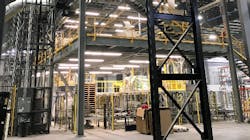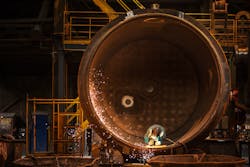It’s a scenario any manufacturer should be happy to face: soaring demand for its products. How can customers clamoring for every widget that rolls off the assembly line or exits a work cell be anything but good news? Surely this is the dream of every brick-and-mortar company that makes stuff.
Perhaps. Even probably. And in a large percentage of cases, most assuredly. But growing demand also raises a fleet of challenges, not the least of which is how to meet it. Do you focus on optimizing your current processes to increase throughput? Do you outsource some of the production? Do you expand an existing site? Do you go to the extreme and build a new plant?
The short answers to those questions are “yes” and the ever popular “it depends.” Because, indeed, any course you choose comes with risks, rewards and ramifications—and getting it wrong could be costly. Peloton Interactive’s recent travails provide a stark example. A huge reversal of fortune at the fitness equipment maker culminated in February with a change in leadership, layoffs and a decision to stop work on a massive greenfield manufacturing plant that was under construction in Ohio. That new site had been announced with high hopes less than a year previously.
“We often had to act quickly, with limited visibility. For example, in the face of supply chain disruptions and delivery delays, we invested heavily in near-term capacity, inventories and logistics to protect our (m)ember experience,” explained co-founder and then-CEO John Foley in a letter posted on the Peloton website.
With the post-COVID demand picture looking quite different than anticipated, “these investments no longer align with how we intend to operate our business going forward,” Foley wrote.
While the future is never fully knowable, choosing how to better align capacity with demand is not a guessing game. Any decision, every decision, begins with a look at the data.
Make Sure the Demand Is Real—and Sustainable
In September 2021, Pittsburgh-based HarbisonWalker International announced it would develop a manufacturing hub to meet increased demand from its U.S. steel customers, and recently it outlined what that investment will entail. The manufacturer of refractory products will repurpose a closed property it has in Alabama and expects to open the converted facility before the end of 2022.
Over the past few years, the company also has invested in upgrades at several U.S. facilities and in 2018 built a greenfield site in southern Ohio.
A wealth of data underpins the company’s decisions, understandably so. When big-dollar investments are potentially at stake, it’s imperative to have a robust understanding of demand growth—whether it’s driven by a temporary shock or has long-term, sustainable potential; whether it’s a result of capturing a greater share of a shrinking market or outgunning competitors in an expanding market.
The Pittsburgh company’s review of economic indicators can include everything from the producer price index and GDP to new housing and commercial construction starts. Jackson places particular emphasis, however, on performing the due diligence necessary to understand customers’ needs—and looks even further downstream, to their customers’ customers.
“That link to customer needs and where markets are going is so critical for us in driving decisions,” she says.
And “where markets are going” means that research extends beyond sheer demand calculations. It’s also about how industries may be changing and reacting to those changes. For example, the steel industry has made a commitment to green technologies, which has implications for HarbisonWalker.
“It doesn't necessarily mean a lot more product; it means different type of products,” Jackson says. “So, we need to build in some flexibility into our capability of running different types of products to support that changing need.”
“There are a lot of factors at play,” she says.
Evaluate Options to Address Demand
Those factors don’t always paint a clear picture about whether it’s time to construct a new facility, which can potentially take years. Moreover, adds consultant and author Mark Lado, “I would explore all other opportunities before establishing a new brick and mortar facility, because every other opportunity, or every other alternative that you’re looking at requires a little less internal resource management. Once you start up a new brick and mortar facility, it’s a strain across every single function.”
An obvious—and less risky—option is to determine whether more can be produced within a manufacturer’s current footprint. Such thinking is routine at HarbisonWalker. The team is “always first and foremost looking to extract maximum potential out of that existing capability. So we've got efficiency improvement projects, capital improvement projects. We’re big on business improvement,” Jackson says. “We have to ensure to ourselves and to our investors that we’re maximizing the potential of what we’ve got.”Yet many manufacturers don’t realize the full potential of their existing manufacturing space, says the Boston Consulting Group’s Dustin Burke. “In the majority of facilities that we see with our clients, there’s often still a lot that can be captured by investing into existing facilities,” says the co-leader of BCG’s manufacturing and supply chain topic.
He points to automation as one means to add capacity at a smaller price point than building an entirely new factory. “The financial returns on automation investments are even more attractive when we think about them as a way to increase throughput, which they often are.”
Whether it’s adding automation or improving processes, however, the challenge once again is data driven. Many manufacturers don’t have a good handle on what their facilities are truly capable of in terms of capacity, the BCG consultant says.
“It’s actually very common that companies don’t really understand what the capacity is of different forms of equipment, and when that equipment is tied together in a line, what the capacity of that line is,” Burke adds. Moreover, gathering such data can be time-intensive, but “it’s essential.”
Alternatively, companies may have lots of data “but no idea what it’s telling them,” according to Lado.
Similar to Burke, Lado cites automation as one means to increase capacity and points to several others. Can a change in work hours or additional labor ease an immediate strain, he asks? Perhaps a new factory layout? Are internal quality issues and the added rework that accompanies them inflating capacity constraints? Might it be worthwhile to outsource less valued-added work that nevertheless requires a significant footprint and replace it with processes that contribute more value?
Options may not be limitless, but data can guide the way forward.
Risk and Reward Equation
In January, Miller Fabrication Solutions announced that it had purchased a vacant building in an industrial park that would become, with minimal renovations, its fourth manufacturing plant in Pennsylvania. The decision to expand the company’s footprint was several years in the making, even excluding any delay caused by the pandemic.
Demand was strong, the company wasn’t yet operating at capacity, but “at the same time, we saw the pipeline growing to the point where in a little bit of time we were not going to be able to support it,” Miller says.
The recent purchase increases Miller Fabrication’s shop-floor space by about 35%. The company plans to consolidate its parts production at the new site and streamline production across its other three facilities. Moreover, the added space provides an opportunity to explore automation, such as automated guided vehicles and other technologies.
“Automation is great, but it takes space,” Miller notes.
Workforce demographics play a role in how Miller Fabrication plans to deploy its expanded footprint. “We look at a lot of trends, and one of them is labor and demographics. And it's not lost on me, or really anyone… that we have a bit of a vacuum of talent,” Miller notes. “We’re going to have retirements, big quantities, and there’s not enough people coming behind to fill those voids. We have a situation where we have got to lay out our facilities so that we’re more productive, and we have better flow. It’s going to be critical.
“I think it’s going to require all manufacturers to take a different look at labor and say, ‘What tasks can we really try to eliminate?’”
Miller recognizes the risks involved with purchasing a new building. As he says, the investment was “not insignificant.” However, the decision was not made for today’s circumstances, but also for five to 10 years down the road.
“We can’t just capitalize on the now,” he says. The expansion “may open other opportunities to us that we’re (presently) just not able to do because we don’t have the resources. In the future it opens those doors.”
No Perfect Information, No Perfect Time
Regardless of the depth of a company’s research or the robustness of its strategic planning process, there will never be perfect information about demand growth. As the pandemic showed, circumstances can change swiftly. Exploding growth one day can evaporate the next.
If anything good has come out of the past few years of volatile demand, it’s that manufacturers appear willing to spend more time trying to understand the drivers of growth, says BCG’s Burke.
Don’t get seduced by the siren call of rising orders. Do perform your due diligence.
About the Author
Jill Jusko
Bio: Jill Jusko is executive editor for IndustryWeek. She has been writing about manufacturing operations leadership for more than 20 years. Her coverage spotlights companies that are in pursuit of world-class results in quality, productivity, cost and other benchmarks by implementing the latest continuous improvement and lean/Six-Sigma strategies. Jill also coordinates IndustryWeek’s Best Plants Awards Program, which annually salutes the leading manufacturing facilities in North America.
Have a story idea? Send it to [email protected].




